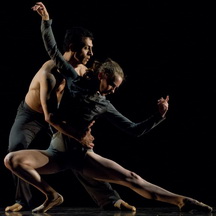When LINES Ballet describes itself as a “contemporary ballet company with a global artistic vision” it isn’t just rhetoric generating publicity copy, as last weekend’s series of performances clearly demonstrated. On stage at Yerba Buena Center for the Arts, the acclaimed dance company joined seven monks from the Shaolin USA temple for an extraordinary two-hour concert, Long River High Sky, in which performers at the top of their art and physical prowess interwove their disciplines in an imaginative synthesis of American ballet and Chinese martial arts.
Conceptually, it seems an awkward combination: an art developed out of courtly European dance merging with combat art refined from fighting with “bandits and foreign invaders.” Watching the two groups move together and separately, an even greater contrast is revealed: one located in the body. The tall, lanky ballet dancers stood in contrast to the compact, acrobatically muscled monks.
The disciplines’ movements have grown out of those differences of body. In ballet the body’s muscular focus is centered in the circle of the pelvis, from which the back, arms and legs extend as if to escape in some celestial explosion. This is especially true in King’s choreography.
Even though the dancer’s visual focus may be curved toward the ground—a perspective taken from modern dance technique—the back continues to return to a lifted skyward position, as if the elements of the body were in tension to each other. Such tension gives this contemporary master’s ballet its dynamic force, more than virtuosic leaps or turns.
In Chinese martial arts, the body’s muscular force is located lower in the pelvis, with the muscular tension constrained to the thighs below. The gesture of the movement is toward the ground and stability. Even in the tremendous leaps and flying kicks the body is pulled into itself, perhaps to allow as little target as possible to the enemy and to allow the muscles great elasticity as they hit the ground and bounce back into awareness, ready for attack. The monks performed several solos. Among them the awe-inspiring “drunken” staff form performed by Shih Yansong.
King played with this contrast in two duets with Shi Yanliang and Meredith Webster and Shi Yanzhong and Laurel Keen. Choosing his thinnest, tallest female dancers—each stood some five inches taller than her monk partner, King wove the dancers and martial artists together, giving the dancer an opening movement of a long arabesque in penché—an arabesque in which the back is allowed to drop so that the rear leg may be raised higher, almost into a standing split—and placing the monk into a long lunge forward to the ground. The contrast continued through the duet, emphasizing the extraordinary difference in gesture while constantly placing before the viewer the fact of each form’s physical grace and power.
The idea was repeated in various ways: in one, the dancers formed a living fence upstage—hands held, their arms lifted, which served to emphasize their differing heights and their upright postures—while two or three monks spun and leaped center downstage. Often King blended movements by having one the monks begin a series of movements that was then echoed by the dancers in ballet vocabulary but subtly, in ways that were revelatory rather than imitative.
In the second half of the program there were interludes in which the dancers’ ensemble performed a martial arts form led by a monk. These were charming, though not as inventive, as other mirrorings. The performance closed with the ensemble moving through a martial arts form while individuals—both dancers and monks—would break away to perform short solos in the midst of their fellow performers.
Melody of China was the collaborating musical trio, and though they were over amplified, they performed superbly. It was a breathtaking collaboration: one I will remember for years to come.
Jaime Robles
Originally published by the Piedmont Post
